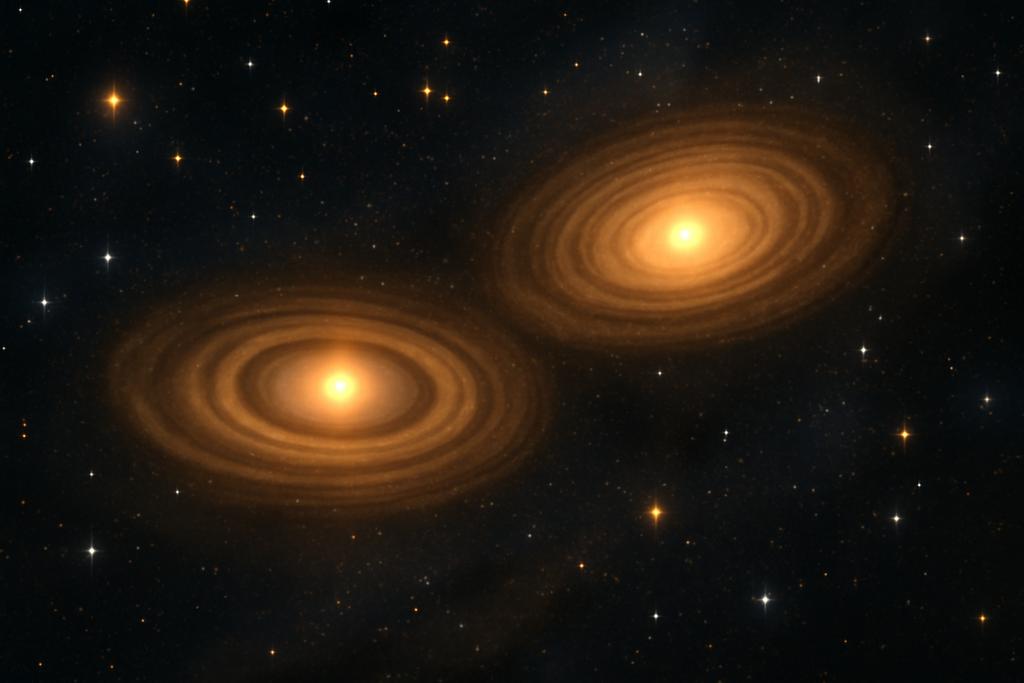When Two Stars Dance, Their Disks Tell Different Stories
In the cosmic theater of star formation, most stars don’t perform solo. Instead, they come in pairs or even larger ensembles, locked in gravitational embraces that shape their surroundings in profound ways. A new study led by Nicolás T. Kurtovic at the Max Planck Institute for Extraterrestrial Physics peels back the curtain on how these stellar duets sculpt the chemistry and physics of their planet-forming disks, revealing a surprising divide in the watery worlds swirling around each star.
Using the James Webb Space Telescope’s Mid-Infrared Instrument (JWST/MIRI), the team focused on three young binary systems—VW Cha, WX Cha, and RW Aur—each hosting two stars with their own circumstellar disks. These disks are the cradles of future planets, composed of gas and dust that orbit the stars. The question: how does the presence of a close stellar companion influence the inner disk chemistry, especially the abundance of water, a key ingredient for life?
Primary Stars Overflow with Water While Secondaries Run Dry
The JWST’s exquisite mid-infrared eyes allowed the researchers to separate the light from each star’s disk, a feat impossible with previous instruments for binaries this close. What emerged was a striking pattern: the disks around the primary stars—the more massive or dominant members—were bursting with water vapor emission lines, some of the richest water spectra ever seen in young stars. Meanwhile, their secondary companions’ disks were mostly silent, showing few molecular lines and a much weaker water signature.
This dichotomy is puzzling because many of these binaries have stars of similar mass, so why such a stark difference in their inner disk chemistry? The answer likely lies in the complex gravitational interplay between the stars and their disks. The presence of a companion star can truncate and warp disks, stirring up material and influencing how icy pebbles drift inward. This radial drift is crucial because it delivers water ice from the cold outer disk to the warmer inner regions where it sublimates into vapor.
RW Aur’s Tale of Two Disks
The RW Aur system offers a vivid example. Both stars have disks of comparable size and mass, yet RW Aur A’s disk is water-rich, while RW Aur B’s disk shows only faint traces of water and other molecules like HCN and CO2. ALMA observations reveal that RW Aur B’s disk sports a cavity about 4 astronomical units wide—a gap that likely disrupts the inward flow of icy material, starving the inner disk of water vapor. In contrast, RW Aur A’s disk appears full and possibly warped, hinting at dynamic past interactions that may have enhanced its water content.
Jets, Winds, and Ionized Neon: The Stellar Weather Report
Beyond water, the study also detected jets of ionized neon ([Ne II]) streaming away from the primary stars, a hallmark of energetic outflows that can shape disk evolution. These jets were spatially resolved in RW Aur, WX Cha, and DF Tau, another binary included for comparison. Interestingly, the secondary stars showed low-velocity neon and argon emission, suggesting ionized winds rather than fast jets. The ratios of these ionized gases hint at the high-energy radiation environment bathing these disks, with some secondaries experiencing stronger extreme ultraviolet (EUV) fields than their primaries.
Variability: A Dynamic Dance Over Years
Comparing JWST data with archival Spitzer observations from 15 years prior revealed that some disks, like VW Cha A, have changed dramatically in their water emission. The team interprets this as a change in the emitting area of water vapor, possibly linked to fluctuations in accretion—the process by which gas spirals onto the star. RW Aur A showed significant variability in its mid-infrared continuum, likely tied to thermal instabilities in its innermost disk regions, but its water lines remained steady, suggesting the molecular gas lies farther out.
Extended Molecular Glow: Tracing Past Encounters
The JWST also uncovered extended emission from molecular hydrogen (H2) around these binaries, often shaped like bowls or arcs. In RW Aur, this emission matches the morphology of cold gas arcs seen by ALMA, relics of a close stellar fly-by about 300 years ago that launched material into eccentric orbits. These structures offer a rare glimpse into how stellar interactions can fling gas and dust far from their birthplaces, potentially influencing planet formation.
Why It Matters
This study highlights the intricate and sometimes surprising ways binary stars influence their planet-forming environments. The stark contrast in water vapor between primary and secondary disks challenges simple models where disk chemistry depends only on stellar mass or age. Instead, it points to the importance of disk structure, dynamical interactions, and radiation fields in shaping the volatile inventory that future planets inherit.
Understanding these processes is crucial because water is a cornerstone for habitability. If binary companions can starve some disks of water vapor, it may affect the likelihood of forming water-rich worlds in these systems. Moreover, the findings underscore the power of JWST combined with other observatories like ALMA to unravel the complex physics and chemistry of young stellar systems.
Looking Ahead
Future high-resolution observations, especially with ALMA, will be key to mapping the outer disks of these binaries and constraining their orbits, helping to untangle the history of their interactions. Multi-epoch monitoring with JWST could track how accretion variability and disk warps influence molecular emission over time. Together, these efforts will deepen our understanding of how stars and their companions choreograph the early stages of planet formation, setting the stage for the diversity of planetary systems we observe today.
Reference: Kurtovic et al., “Young binary systems with JWST/MIRI: variable water-rich primaries and extended emission,” Astronomy & Astrophysics, 2025, Max Planck Institute for Extraterrestrial Physics.










